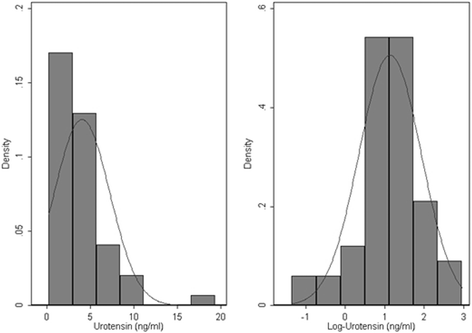Plasma Urotensin II levels in children and adolescents with chronic kidney disease: a single-centre study
- PMID: 28359257
- PMCID: PMC5374664
- DOI: 10.1186/s12882-017-0530-9
Plasma Urotensin II levels in children and adolescents with chronic kidney disease: a single-centre study
Abstract
Background: Increased plasma Urotensin II (UII) levels have been found in adults with renal diseases. Studies in children are scarce. The objective of the study is to estimate plasma UII levels in subjects with chronic kidney disease (CKD) stages 3 to 5 and renal transplant recipients (RTR). In addition, the correlation of UII with anthropometric features and biochemical parameters was assessed.
Methods: Fifty-four subjects, aged 3 to 20 years old, 23 with CKD, 13 with end-stage kidney disease (ESKD) undergoing hemodialysis (HD) and 18 RTR were enrolled. A detailed clinical evaluation was performed. Biochemical parameters of renal and liver function were measured. Plasma UII levels were measured in all patients and in 117 healthy controls, using a high sensitive enzyme immunoassay (EIA) kit. All data were analyzed using STATA™ (Version 10.1).
Results: Median UII and mean log-transformed UII levels were significantly higher in CKD and RTR patients compared to healthy subjects (p < 0.001). HD patients had higher but not statistically significant UII and log-UII levels than controls. UII levels increased significantly at the end of the HD session and were higher than controls and in line to those of other patients. The geometric scores of UII in HD (before dialysis), CKD and RTR patients increased respectively by 42, 136 and 164% in comparison with controls. Metabolic acidosis was associated with statistical significant change in log-UII levels (p = 0.001). Patients with metabolic acidosis had an increase in UII concentration by 76% compared to those without acidosis.
Conclusions: Children and adolescents with CKD, particularly those who are not on HD and RTR, have significantly higher levels of UII than healthy subjects. UII levels increase significantly at the end of the HD session. The presence of metabolic acidosis affects significantly plasma UII levels.
Keywords: Acidosis; End-stage kidney disease; Hemodialysis; Renal failure; Renal transplantation.
Figures
Similar articles
-
Urotensin II in the development and progression of chronic kidney disease following ⅚ nephrectomy in the rat.Exp Physiol. 2019 Mar;104(3):421-433. doi: 10.1113/EP087366. Epub 2019 Jan 15. Exp Physiol. 2019. PMID: 30575177 Free PMC article.
-
Renal impairment, hypertension and plasma urotensin II.Nephrol Dial Transplant. 2011 Feb;26(2):609-14. doi: 10.1093/ndt/gfq416. Epub 2010 Jul 9. Nephrol Dial Transplant. 2011. PMID: 20621933 Free PMC article.
-
Urotensin II levels in patients with chronic kidney disease and kidney transplants.Ups J Med Sci. 2012 Mar;117(1):22-7. doi: 10.3109/03009734.2011.626541. Epub 2011 Nov 18. Ups J Med Sci. 2012. PMID: 22098077 Free PMC article. Clinical Trial.
-
PCSK9 in chronic kidney disease.Int Urol Nephrol. 2017 Jun;49(6):1015-1024. doi: 10.1007/s11255-017-1505-2. Epub 2017 Jan 13. Int Urol Nephrol. 2017. PMID: 28084558 Review.
-
Urotensin II system in chronic kidney disease.Curr Res Physiol. 2024 May 7;7:100126. doi: 10.1016/j.crphys.2024.100126. eCollection 2024. Curr Res Physiol. 2024. PMID: 38779598 Free PMC article. Review.
Cited by
-
Plasma Brain Natriuretic Peptide Levels in Children with Chronic Kidney Disease and Renal Transplant Recipients: A Single Center Study.Children (Basel). 2022 Jun 19;9(6):916. doi: 10.3390/children9060916. Children (Basel). 2022. PMID: 35740855 Free PMC article.
-
Urotensin II system contributes to ischemic acute kidney injury in neonatal pigs.Ren Fail. 2025 Dec;47(1):2534018. doi: 10.1080/0886022X.2025.2534018. Epub 2025 Jul 24. Ren Fail. 2025. PMID: 40707413 Free PMC article.
-
Urotensin II in the development and progression of chronic kidney disease following ⅚ nephrectomy in the rat.Exp Physiol. 2019 Mar;104(3):421-433. doi: 10.1113/EP087366. Epub 2019 Jan 15. Exp Physiol. 2019. PMID: 30575177 Free PMC article.
-
Biomarkers in Cardiorenal Syndromes.Biomed Res Int. 2018 Mar 5;2018:9617363. doi: 10.1155/2018/9617363. eCollection 2018. Biomed Res Int. 2018. PMID: 29693019 Free PMC article. Review.
References
MeSH terms
Substances
LinkOut - more resources
Full Text Sources
Other Literature Sources
Medical



